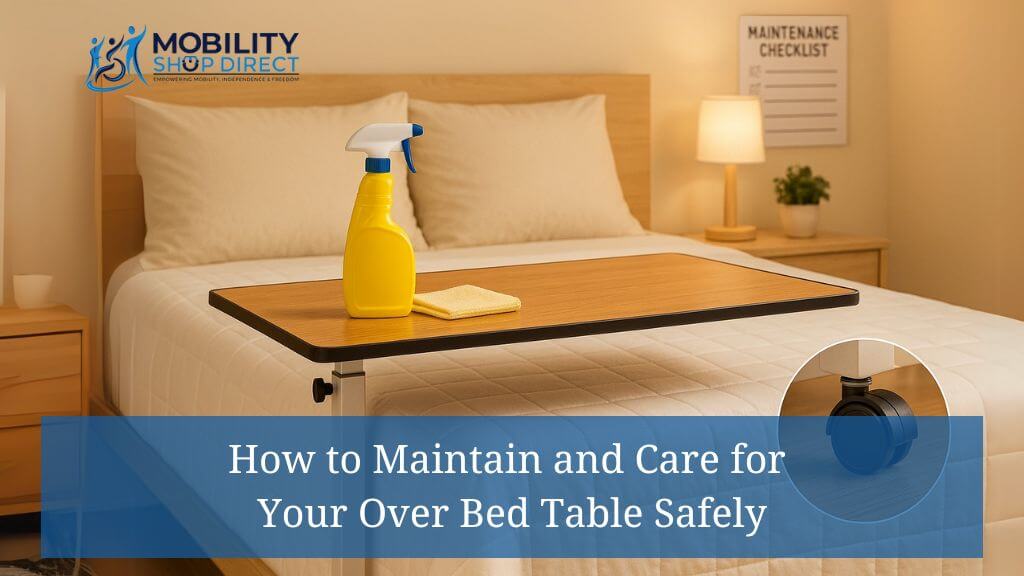Caring for an over bed table might not seem like a top priority, but overlooking its maintenance can lead to hygiene problems, frustrating mechanical failures, and even safety risks. Whether you use your table for meals, medical equipment, or everyday convenience, proper upkeep is essential to ensure it remains reliable, functional, and long-lasting. Consistent care also helps you avoid the cost of frequent repairs or replacements.
This guide breaks down simple ways to keep your over bed table in good shape; cleaning, inspecting, and making minor adjustments. From fixing sticky wheels to keeping the surface in great condition, these tips will help you stay ahead of wear and tear. We’ll also cover key maintenance habits that can improve safety and make your table easier to use every day.
Let’s get into the details and help you get the most out of this useful piece of furniture.
Table of Contents
- Benefits of Proper Over Bed Table Upkeep
- Common Issues from Neglecting Maintenance
- Step-by-Step Guide to Cleaning Your Over Bed Table
- Maintaining Over Bed Table Wheels for Smooth Mobility
- Ensuring Height Adjustment Mechanisms Work Perfectly
- Routine Safety Checks for Over Bed Tables
- Protecting and Prolonging the Surface Material
- FAQs About Over Bed Table Maintenance
- Key Takeaways
- Conclusion
Benefits of Proper Over Bed Table Upkeep
Regular maintenance may seem tedious, but it pays off. A well-maintained table lasts longer, works better, and is safer to use. Here's why it's worth the effort:
- Increased Lifespan: Basic upkeep helps your table last longer and prevents expensive repairs or early replacements. It also cuts down on waste, which is a nice bonus.
- Better Hygiene: Whether you're eating meals or storing medical supplies, keeping the surface clean helps stop bacteria from building up.
- Improved Safety: Working wheels, smooth height adjustments, and a sturdy frame help prevent accidents and frustration.
If you're buying a new one or already have a table with wheels, you can learn more about the benefits of wheeled over bed tables in this guide.
Common Issues from Neglecting Maintenance
Ignoring upkeep can lead to:
- Sticky Height Adjustments: Dirt or lack of lubrication can make it hard to raise or lower the table.
- Bad Wheels: Debris or rust can make the table hard to move, or even unstable.
- Damaged Surface: Stains and scratches aren’t just ugly; they can trap bacteria and make cleaning harder.
If you’re just getting familiar with how over bed tables work, this breakdown of over bed table types and features is a helpful place to start.
Step-by-Step Guide to Cleaning Your Over Bed Table
How to Clean an Over Bed Table Effectively
Stick to these steps to keep things simple:
- Use a mild, non-abrasive cleaner on a soft cloth.
- Stay away from bleach or ammonia-based cleaners.
- Clean daily if the table gets a lot of use, or weekly for occasional use.
Always spray the cloth; not the table; so cleaner doesn't seep into joints or seams. Corners and edges are magnets for crumbs and dust, so give those extra attention.
Best Cleaning Products for Over Bed Tables
- Use gentle cleaners made for delicate surfaces.
- A few drops of dish soap in warm water works well too.
- Skip anything rough or abrasive that could scratch the surface.
If you want to go deeper into safe cleaning, check out this full guide on maintaining and cleaning over bed tables.
Maintaining Over Bed Table Wheels for Smooth Mobility
How to Clean Debris from Caster Wheels
- Flip the table carefully so you can reach the wheels.
- Use a toothbrush to loosen dust and dirt.
- Remove stuck debris with tweezers or a small knife.
- Wipe clean with a damp cloth.
How to Lubricate Over Bed Table Wheels
- Use a silicone-based spray on the wheel axles.
- Spin the wheels by hand so the lubricant spreads evenly.
- If they’re still rough, check if the casters are worn out.
When and How to Replace Wheel Casters
- Check your manual to find compatible replacements.
- Remove the damaged wheels by pulling or unscrewing them.
- Push in or screw on the new ones until they’re secure.
To shop a range of adjustable and mobile options, take a look at our full over bed table collection.
Ensuring Height Adjustment Mechanisms Work Perfectly
Testing the Height Adjustment Feature
- Raise and lower the table slowly. Look for jerks or resistance.
- Check for dirt buildup or worn parts around the mechanism.
Fixing a Sticky Height Adjustment Mechanism
- Clean around the moving parts.
- Apply the right kind of lubricant; usually silicone or graphite.
- Refer to the manual for fine-tuning settings if needed.
Routine Safety Checks for Over Bed Tables
Monthly Over Bed Table Safety Checklist
- Tighten all screws, bolts, and brackets.
- Test for wobble or instability.
- Make sure the wheels and height adjustments work smoothly.
Addressing Structural Issues Immediately
Small problems can get worse fast. Use a screwdriver or wrench to tighten things. If parts look bent or cracked, it's better to replace them than risk injury. If you're unsure, get a professional opinion.
Protecting and Prolonging the Surface Material
How to Prevent Scratches and Stains
- Use coasters, placemats, or trays under plates, drinks, and tools.
- Don’t put hot items or sharp objects directly on the surface.
Caring for Specialty Table Surfaces
- Use wood polish for timber surfaces.
- Follow manufacturer instructions for plastic or composite tops.
FAQs About Over Bed Table Maintenance
How Often Should Over Bed Tables Be Cleaned?
Clean daily if used for meals. For less frequent use, once or twice a week is enough.
What Cleaning Products Are Safe for Over Bed Table Surfaces?
Stick with mild dish soap and water, or a gentle cleaner for sensitive surfaces.
How Do I Fix a Height Adjustment That Won’t Stay in Place?
Clean and lubricate the mechanism. Then refer to the manual for proper settings.
When Should I Replace Wheels or Other Components?
When you notice wobbling, cracks, or if the table becomes hard to move smoothly.
Key Takeaways
- Clean Regularly: Keeps the table hygienic and looking good.
- Maintain the Wheels: Clean and oil them so the table moves easily.
- Adjust with Care: Test and lubricate the height feature when needed.
- Check for Safety: Tighten any loose parts once a month.
- Protect the Surface: Use pads and avoid direct heat or sharp items.
Conclusion
Taking care of your over bed table doesn’t need to be complicated. A little regular cleaning, occasional checks, and basic maintenance go a long way. These habits help you avoid bigger problems down the line and keep the table working safely for years. Start small, stay consistent, and you’ll get lasting value from this practical tool.



